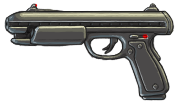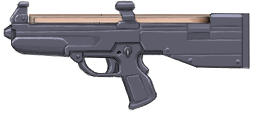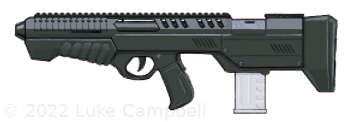|
Needlers, also called needle guns, use an electromagnetic pulse to inductively launch a projectile enclosed in a superconducting sabot at hypervelocity speeds.
The typical projectile is a fin-stabilized flechette, hence the name "needler".
Unlike other induction guns, the battery is included in each magazine with enough energy to shoot every dart in the magazine; battery energy does not have to be tracked separately.


| | Needler sabot cartridge (above) and bare flechette (below).
|
The large, hypervelocity projectiles of the bigger needle cannons can impact so fast that they – and any matter in their way when they hit – literally explode. The listed blast damage is taken separately in addition to any other damage that may occur.
For blast damage, the reference range score for damage falloff is listed in the Spread column.
Blasts only occur for projectiles moving with a Speed of 400 or more.
The high speed and low mass of a needler's darts generate little recoil, allowing needlers to fire rapidly while maintaining control. Most needlers allow shooting three round bursts with one pull of the trigger, giving something of a shotgun effect and somewhat overcomming the relatively limited wounding potential of the small darts. For civilian applications, heavier darts are often used to increase the size of the wound channel at the expense of penetration of hard armor. This leads to more rapid incapacitation of game animals and makes a shot more likely to drop an assailant in a self-defense situation. The military usually uses light darts to maximize armor penetration.
Needlers produce a "rip" or "crack" sound from the shockwaves of their Mach 6 projectiles punching through the air, but are otherwise quiet. The main visual indication of their firing are the fluttering shreds of sabot that fall off the projectile dart as soon as it leaves the muzzle.
The impact of a needle can be quite loud, however, and if they are going fast enough to produce a blast they will also make a bright fireball and potentially throw sparks, splatter, or other debris from where they hit.
| Description | Pen | Wound | AP | ROF | Ammo | Bulk | Aim | RCL | Str | Spread | DA | Speed | PSz | Sig | Mass | Price | | Mini Needle Pistol | 7.5 | -2½ | -5 | s,b3 | 60 | -1 | +1 | -9 | -3 | +20 | 350 | 500 | -15 | +6 | 0.45|0.018 | 18|0.8(0.45) | | Needle Pistol | 9 | -1¾ | -5 | s,b3 | 120 | +0 | +2 | -7 | -1 | +20 | 450 | 500 | -14 | +7 | 1|0.07 | 35|3(1.8) | | Heavy Needle Pistol | 11 | -1½ | -5 | s,b3 | 90 | +0 | +2 | -5 | +0 | +20 | 500 | 500 | -13½ | +8 | 1.5|0.08 | 60|3.5(2) | | VROF Needle Carbine | 9 | -1¾ | -5 | s,b10 | 600 | +2½ | +4 | -10 | -3 | +25 | 450 | 500 | -14 | +7 | 2.5|0.35 | 80|15(10) | | Needle Carbine | 18 | -1 | -5 | s,b3 | 150 | +3 | +4 | -6 | -1 | +25 | 800 | 500 | -13 | +9 | 3.5|0.35 | 120|15(8) | | Needle Rifle | 22 | -½ | -5 | s,b3 | 60 | +3½ | +5 | -4 | +0 | +25 | 1k | 500 | -12½ | +9 | 5|0.2 | 200|8(5) | | Magnum Needle Rifle | 28 | -½ | -5 | s,b3 | 45 | +4½ | +5 | -3 | +1 | +25 | 1k | 500 | -12 | +10 | 7|0.2 | 300|8(5) | | Anti-Materiel Needle Rifle | 35 | +1 | -5 | s,b3 | 30 | +5 | +5 | -1 | +3 | +25 | 1.2k | 500 | -11½ | +11 | 12|0.25 | 500|12(7) | | Machine Needler | 35 | +1 | -5 | 10 | 600 | +5 | +5 | -1 | +3 | +25 | 1.2k | 500 | -11½ | +11 | 12+5 | 500|250(150) | | Hvy. Machine Needler | 40 | +1¼ | -5 | 10 | 600 | +5½ | +5 | +1 | +5 | +25 | 1.5k | 500 | -11 | +12 | 25+10 | 1k|450(250) | | Needle B-suit Rifle | 42 | +1¾ | -5 | s | 100 | +5½ | +5 | +2 | +6 | +25 | 1.8k | 500 | -10½ | +13 | 45|2.5 | 1.5k|120(70) | | Lt. Needle Autocannon | 55 | +2½ | -5 | s,10 | 400 | +7 | +5 | +5 | +9 | +25 | 2.5k | 500 | -9½ | +14 | 100+25 | 4.5k|1.2k(700) | | Med. Needle Autocannon | 70 | +3 | -5 | 10 | 400 | +8 | +5 | +7 | +11 | +25 | 3.5k | 500 | -9 | +15 | 180+50 | 7k|2k(1.2k) | | Blast | -3 RS | | (7) | | | | | | | -2 | | | | | | | | Hvy. Needle Autocannon | 120 | +4¾ | -5 | 10 | 400 | +9½ | +5 | +11 | +15 | +25 | 6k | 500 | -7½ | +17 | 800+200 | 30k|10k(6k) | | Blast | -1½ RS | | (7) | | | | | | | -1 | | | | | | | | Lt. Needle Cannon | 400 | +4¾ | -5 | s | 50 | +10½ | +5 | +15 | +19 | +25 | 15k | 500 | -6 | +19 | 3k|80 | 100k|3.5k(2k) | | Blast | -1 RS | | (7) | | | | | | | +0 | | | | | | | | Hvy. Needle Cannon | 450 | +5 | -5 | s | 50 | +11 | +5 | +17 | +21 | +25 | 20k | 500 | -5½ | +20 | 6k|180 | 200k|8k(4.5k) | | Blast | -½ RS | | (7) | | | | | | | +½ | | | | | | | | Needle Artillery | 420 | +7¼ | -5 | s | 50 | +12 | +5 | +20 | +24 | +25 | 18k | 500 | -4½ | +22 | 15k|450 | 500k|18k(10k) | | Blast | +0 RS | | (7) | | | | | | | +1 | | | | | | |
 - Mini Needle Pistol: A compact pistol for concealed carry.
Flechette: 1.5 × 15 mm
Energy per shot: 500 J
 - Needle Pistol: A standard sidearm for self-defense and law enforcement work.
Flechette: 2 × 20 mm
Energy per shot: 1 kJ
 - Heavy Needle Pistol: A larger pistol firing a longer and heavier flechette.
Flechette: 2.5 × 25 mm
Energy per shot: 1.5 kJ
 - VROF Needle Carbine: VROF stands for Very high Rate Of Fire. The VROF carbine is designed to minimize recoil so as to enable highly controlled automatic fire and allow throwing large numbers of flechettes downrange very fast.
Flechette: 2 × 20 mm
Energy per shot: 1 kJ
 - Needle Carbine: A light carbine for clearing houses and vehicles. It is valued for its excellent controllability under automatic fire combined with good ability to penetrate solid armor. Needle carbines are commonly used by SWAT and paramilitary forces and are a common weapon for militias and the Republican Army, particularly for troops expected to operate in confined quarters like vehicle operators.
Flechette: 3 × 35 mm
Energy per shot: 3.5 kJ
 - Needle Rifle: This longarm is a good compromise between armor penetration and rate of fire, providing a threat against highly armored opponents while still allowing suppression fire.
Flechette: 3 × 40 mm
Energy per shot: 5 kJ
 - Magnum Needle Rifle: One of the heaviest-hitting needle rifles available that can still be fired while standing. It is useful for taking down personnel in heavy armor or hunting large game.
Flechette: 3.5 × 45 mm
Energy per shot: 8 kJ
 - Anti-Materiel Needle Rifle: A machine needler fitted with a smaller magazine to cut down on weight, and modified slightly for semi-automatic and burst fire instead of sustained fire. It is a large, hard-hitting needler for destroying equipment and light vehicles.
Flechette: 4.5 × 60 mm
Energy per shot: 15 kJ
- Machine Needler: A squad-support level needler, for sustained automatic fire. It is heavy enough and generates enough recoil that it is usually fired using its bipod for a rest.
Flechette: 4.5 × 60 mm
Energy per shot: 15 kJ
- Heavy Machine Needler: A needle gun for use on a stationary mount, attached to a vehicle, or wielded from a battlesuit.
Flechette: 6 × 70 mm
Energy per shot: 30 kJ
- Needle Battlesuit Rifle: A very large needle rifle designed to be used with powered armor.
Flechette: 6 × 80 mm
Energy per shot: 45 kJ
- Needle Autocannon: A light rapid-fire cannon, commonly mounted on armored fighting vehicles.
- Light Needle Autocannon: Rifle-configuration variants with a bipod are often carried by heavy battlesuits.
Flechette: 8 × 120 mm
Energy per shot: 120 kJ
- Medium Needle Autocannon:
Flechette: 10 × 150 mm
Energy per shot: 200 kJ
- Heavy Needle Autocannon:
Flechette: 18 × 250 mm
Energy per shot: 800 kJ
- Needle Cannon: A cannon for armored fighting vehicles, launching very long aspect ratio flechettes to maximize armor penetration. The blast from the sheer kinetic energy of the impact can have considerable after-armor effect.
- Needle Artillery: A big kinetic-kill artillery piece.
Flechette: 35 × 700 mm
Energy per shot: 15 MJ
Ammunition options
- Flechettes:
Needle gun flechettes are finned needle-shaped darts. The standard flechettes are assumed to be a dense armor-piercing tungsten alloy, and are engineered to tumble in meat and cause most of their damage when going sideways.
- Practice Flechettes: Stamped steel flechettes are commonly used for target practice, general plinking, or hunting. They cost half as much, but AP is decreased by +1.
- High-Mass Flechettes: Flechettes can be made heavier and still be fired from the same gun.
They will not be as fast, will have more recoil, and will have reduced armor penetrating capabilities, but will punch deeper through soft material like flesh and will leave bigger holes.
The table below gives the change to the listed needler stats for different speeds. Remember that adding to AP score decreases the armor piercing ability of the shot.
| Speed | Pen | Wound | AP | RCL
| | 500 | +0 RS | +0 | +0 | +0
| | 400 | +¼ RS | +½ | +1 | +1
| | 350 | +¼ RS | +¾ | +2 | +2
| | 300 | +½ RS | +1 | +3 | +3
|
- Supercavitating Flechettes: In water, normal flechettes have only 1/1000th of their DA range. A supercavitating flechette can go much further underwater – their underwater DA range is 1⁄10th the listed DA range. Because they punch straight through rather than tumbling and fragmenting, Wound is reduced by 4.
- Canister: Multiple projectile loads are available for needle guns, although they are only common for cannon. The shell can be set to burst immediately upon exiting the muzzle, at a given range, or at a given distance from the target. Spread score is +11. For a Shot score of +3½, Pen is at -4 RS, Wound is at -3, and AP is at +3. For every additional -1 RS to Pen and -1 RS to Wound, Shot score increases by +3½ (AP is not further affected).
- Guided: Guided rounds home in on their target, use the rules for guided warheads.
Cost is ×20.
Guided canister rounds are often used to shoot down other projectiles, missiles, drones, aircraft, and other small, unarmored, agile targets.
Back to Vergeworlds Main Page
|









